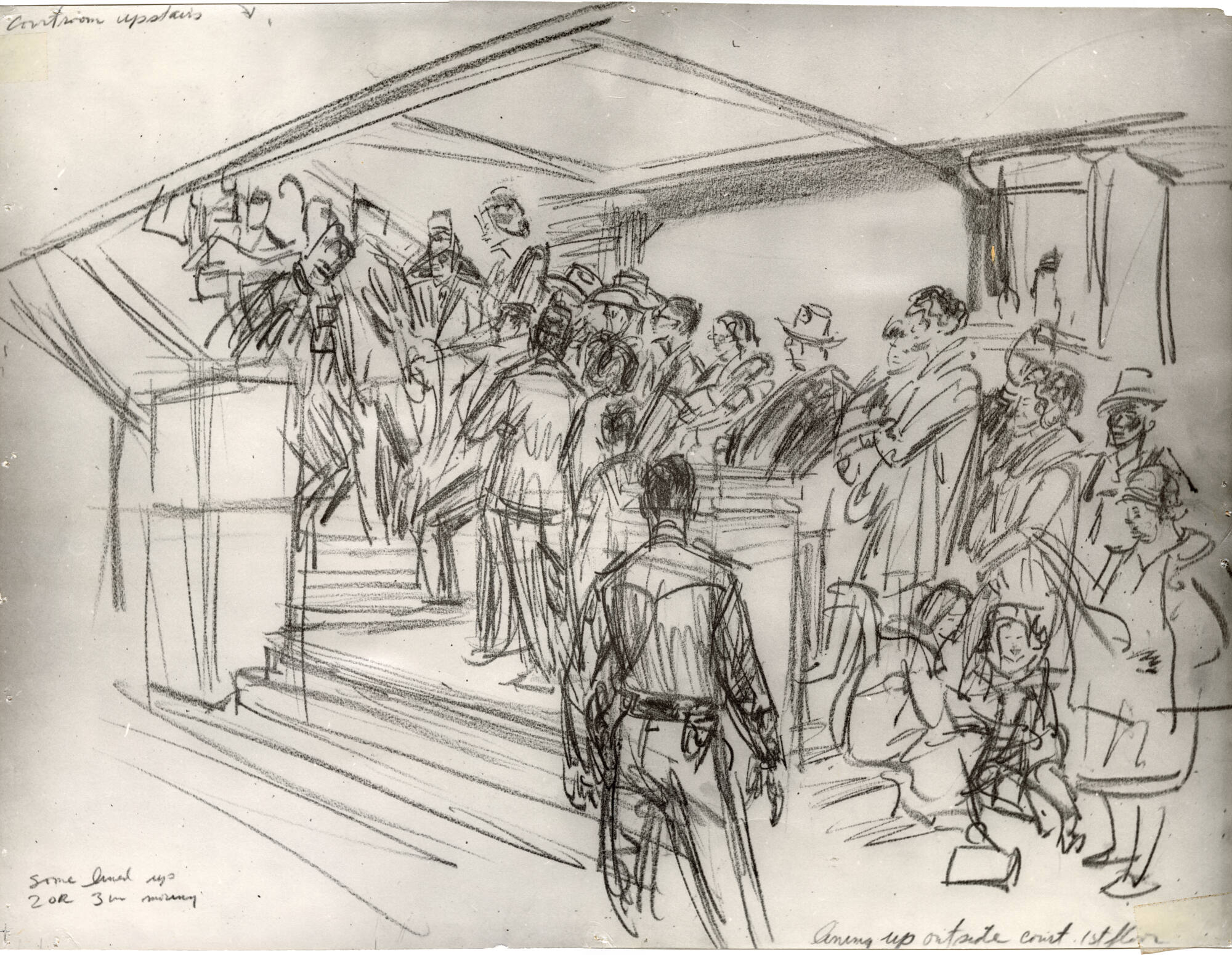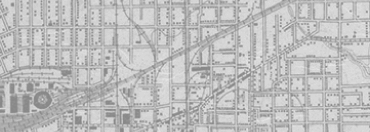


Back
Photograph of courtroom sketch of crowd outside courtroom at Ruby trial
Photograph of courtroom pencil sketch on paper by CBS News courtroom artist Howard Brodie. The sketch shows a crowd filling the stairway if the courthouse during the Jack Ruby trial in February or March of 1964. The sketch shows a police officer in the foreground monitoring the crowd while people line the stairway. Two women are depicted seated at the base of the stairs. Handwritten captions along the top and bottom edge of the image read "courtroom upstairs," "some lined up 2 or 3 in courtroom," and "lining up outside court 1st floor."Brodie made the original pencil sketches for CBS News during the trial of Jack Ruby after the judge barred cameras from the courtroom. Brodie then gave Joe Tonahill this photograph of a courtroom sketch as part of a collection of more than 40 in 1964.
Photograph of courtroom sketch of crowd outside courtroom at Ruby trial
February 1964 - March 1964
Paper, Adhesive tape
14 3/4 × 19 5/16 in. (37.5 × 49.1 cm)
Tonahill Family Partners Collection/The Sixth Floor Museum at Dealey Plaza
2014.034.0041
Howard Brodie (1915-2010) was a sports artist for the San Francisco Chronicle when he enlisted in the U.S. Army with America's entry into World War II. He ultimately became one of the best-known sketch artists of the war, frequently published in the weekly U.S. military magazine, Yank, which ran from June 1942 to December 1945. After the war, Brodie spent the next thirty-five years as a courtroom artist, attending several notable trials including the Chicago Seven, Charles Manson and, of course, the Jack Ruby trial in 1964. For the Ruby trial, Brodie worked as a CBS-TV artist correspondent. Mr. Brodie recorded an oral history with the Museum in 2006. -- Stephen Fagin, Curator
Billed by some reporters as the "trial of the century," the Jack Ruby trial was considered a not-to-be-missed "attraction" for many Dallas residents. Judge J. Frank Wilson's courtroom could accommodate 194 spectators, though at least 150 of those seats were reserved for news media, who had to go through a registration process in order to get credentials to go inside the courtroom. Some of the remaining seats accommodated Ruby family members and guests of the participants. (Judge Brown, for example, invited several friends and colleagues to watch the trial on various days. Melvin Belli invited a few SMU law students to attend one day.) The few remaining seats were open to the public on a first come first-served basis. Everyone admitted into the courtroom, however, had to submit to a manual security check, which was a new concept for many. -- Stephen Fagin, Curator

Photograph of courtroom sketch of crowd outside courtroom at Ruby trial
Photograph of courtroom pencil sketch on paper by CBS News courtroom artist Howard Brodie. The sketch shows a crowd filling the stairway if the courthouse during the Jack Ruby trial in February or March of 1964. The sketch shows a police officer in the foreground monitoring the crowd while people line the stairway. Two women are depicted seated at the base of the stairs. Handwritten captions along the top and bottom edge of the image read "courtroom upstairs," "some lined up 2 or 3 in courtroom," and "lining up outside court 1st floor."Brodie made the original pencil sketches for CBS News during the trial of Jack Ruby after the judge barred cameras from the courtroom. Brodie then gave Joe Tonahill this photograph of a courtroom sketch as part of a collection of more than 40 in 1964.
Photograph of courtroom sketch of crowd outside courtroom at Ruby trial
February 1964 - March 1964
Photographs
Jack Ruby trial
Sketches
Crowds
Trials
Artist
Artwork
Brodie, Howard
CBS News
Dallas
Paper, Adhesive tape
14 3/4 × 19 5/16 in. (37.5 × 49.1 cm)
Tonahill Family Partners Collection/The Sixth Floor Museum at Dealey Plaza
2014.034.0041
Howard Brodie (1915-2010) was a sports artist for the San Francisco Chronicle when he enlisted in the U.S. Army with America's entry into World War II. He ultimately became one of the best-known sketch artists of the war, frequently published in the weekly U.S. military magazine, Yank, which ran from June 1942 to December 1945. After the war, Brodie spent the next thirty-five years as a courtroom artist, attending several notable trials including the Chicago Seven, Charles Manson and, of course, the Jack Ruby trial in 1964. For the Ruby trial, Brodie worked as a CBS-TV artist correspondent. Mr. Brodie recorded an oral history with the Museum in 2006. -- Stephen Fagin, Curator
Billed by some reporters as the "trial of the century," the Jack Ruby trial was considered a not-to-be-missed "attraction" for many Dallas residents. Judge J. Frank Wilson's courtroom could accommodate 194 spectators, though at least 150 of those seats were reserved for news media, who had to go through a registration process in order to get credentials to go inside the courtroom. Some of the remaining seats accommodated Ruby family members and guests of the participants. (Judge Brown, for example, invited several friends and colleagues to watch the trial on various days. Melvin Belli invited a few SMU law students to attend one day.) The few remaining seats were open to the public on a first come first-served basis. Everyone admitted into the courtroom, however, had to submit to a manual security check, which was a new concept for many. -- Stephen Fagin, Curator









